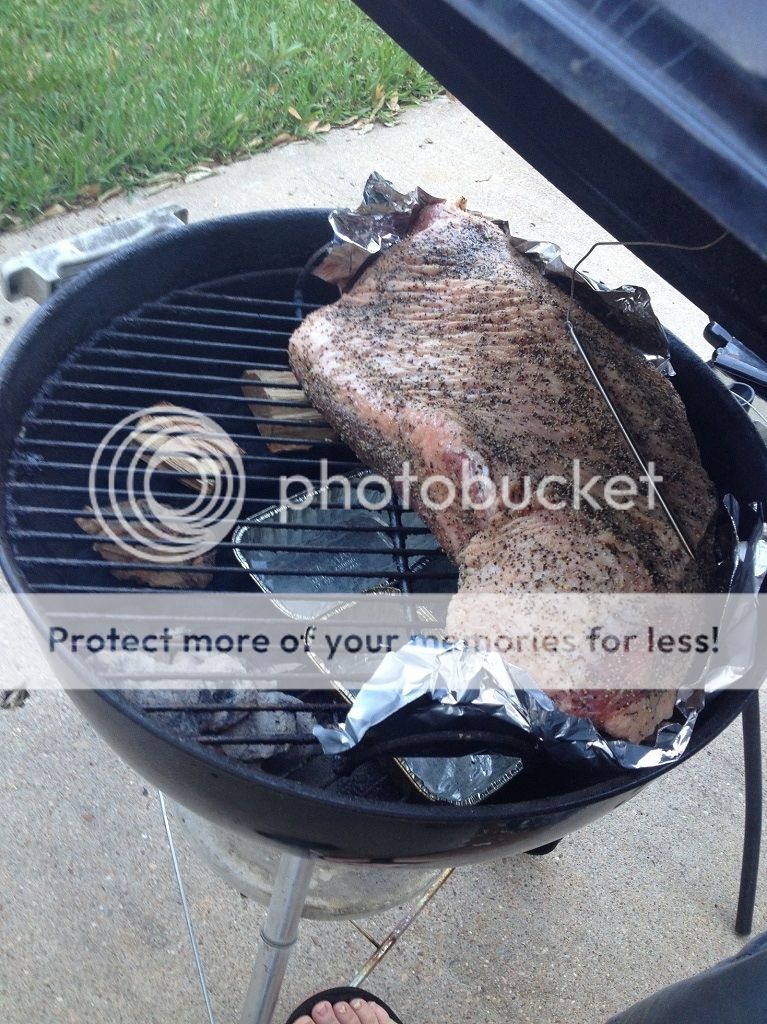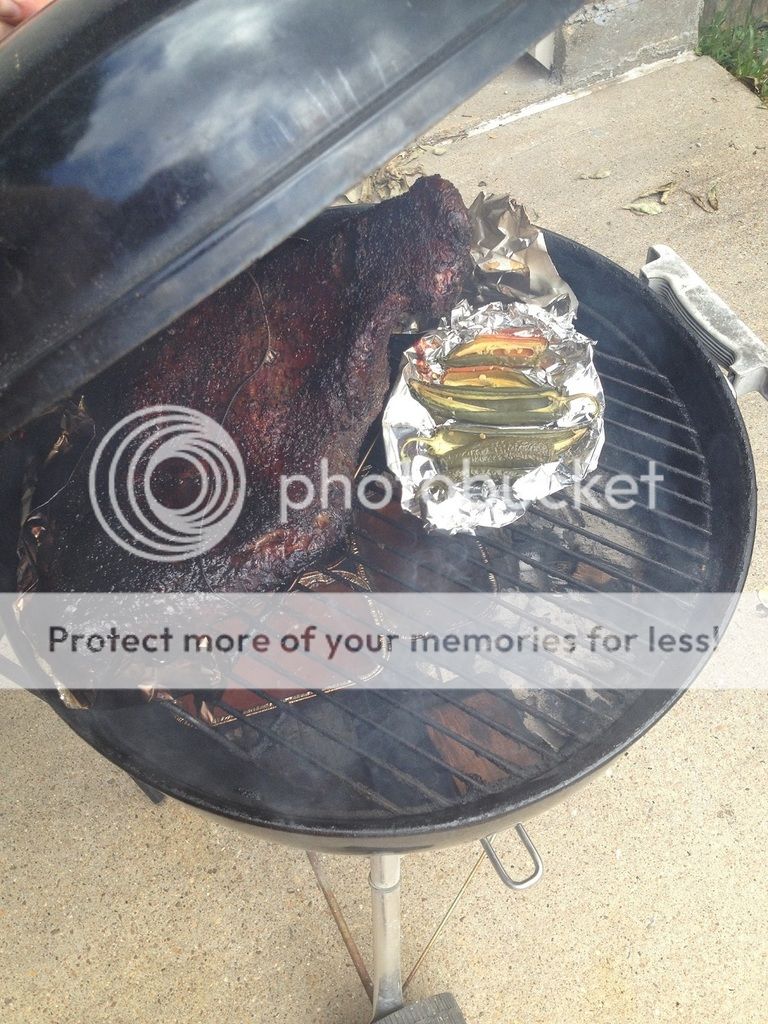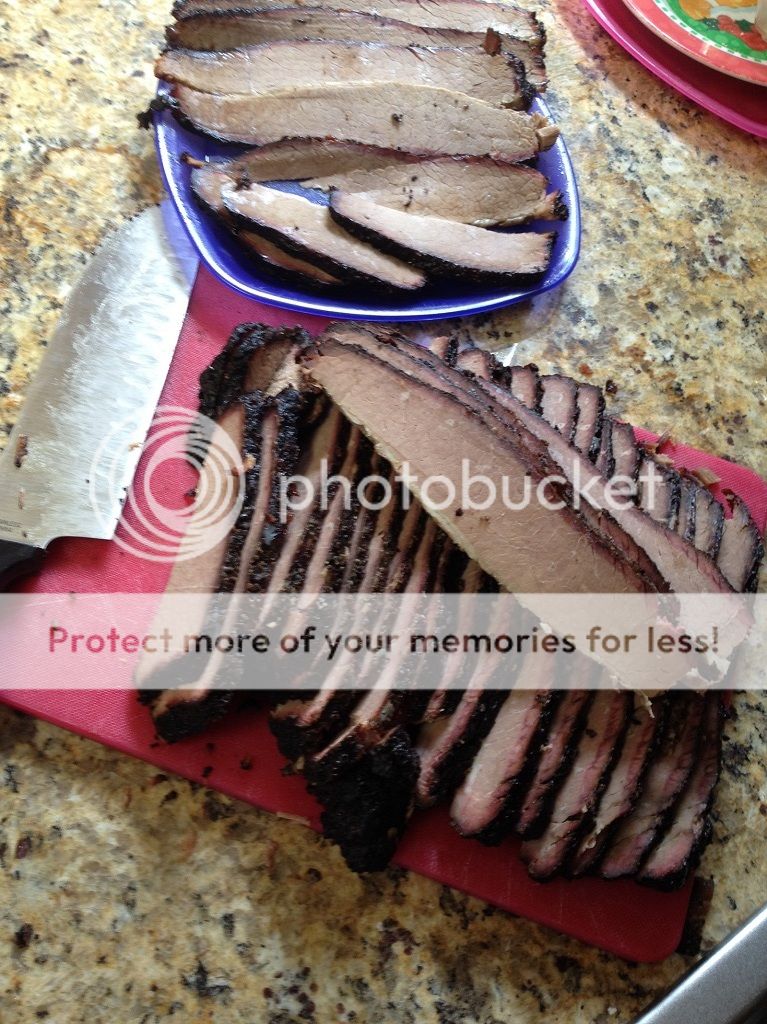H-Towner
Well-known member
- Joined
- Apr 14, 2017
- Location
- Houston, TX
I'm new to the Brethren site. This is my first post outside of Cattle Call and my first indirect cook (besides smoking salmon.) All my outdoor cooking for the last 8 years has been on a hand-me-down 18.5" Weber kettle grill: primarily burgers, dogs, veggies and shrimp. I've been getting interested in smoking, and was looking for inexpensive equipment, but I kept coming across references to the "snake method" of indirect cooking. I figured I could do that on my Weber, so I thought I'd give it a whirl. Here's how it went.
I went out and bought the smallest whole brisket I could find. It was about 9 lb, partially trimmed, USDA select. Cost me just under $20. I seasoned it with kosher salt, coarse pepper, and garlic powder.
Here's a picture of my charcoal snake: 2 wide by 2 high. That's pecan wood on top. This amount of charcoal burned for over six hours before I had to pull the top rack and build a new snake.

Here it is with the 9 lb brisket. The meat takes up most of the grate, so I had to periodically rotate the grate it to keep the meat off the hot coals. I didn't always catch it in time, so the end of the flat got a bit more direct heat than I would have liked. I wasn't sure where to put the thermometer probe in this setup. I ended up tucking it up right next to the meat on the grate, facing the fire.

This was my view for a good portion of the day. There are worse things.

This was over six hours in, shortly before I rebuilt the charcoal snake.

Here's the end result. It was late when I took it off the grill, so we sampled a little, separated the flat from the point, and threw it in the fridge. I sliced it cold the next day; that's why it doesn't look particularly moist.

My takeaway from this experience:
Thanks to everyone who replied. I got some good advice from you. Here's a summary of the key points for posterity.
I went out and bought the smallest whole brisket I could find. It was about 9 lb, partially trimmed, USDA select. Cost me just under $20. I seasoned it with kosher salt, coarse pepper, and garlic powder.
Here's a picture of my charcoal snake: 2 wide by 2 high. That's pecan wood on top. This amount of charcoal burned for over six hours before I had to pull the top rack and build a new snake.

Here it is with the 9 lb brisket. The meat takes up most of the grate, so I had to periodically rotate the grate it to keep the meat off the hot coals. I didn't always catch it in time, so the end of the flat got a bit more direct heat than I would have liked. I wasn't sure where to put the thermometer probe in this setup. I ended up tucking it up right next to the meat on the grate, facing the fire.

This was my view for a good portion of the day. There are worse things.

This was over six hours in, shortly before I rebuilt the charcoal snake.

Here's the end result. It was late when I took it off the grill, so we sampled a little, separated the flat from the point, and threw it in the fridge. I sliced it cold the next day; that's why it doesn't look particularly moist.

My takeaway from this experience:
- The Weber is small. (Maybe I should have tried a chicken first.) Really, it takes a bit of babysitting, but for lack of a proper smoker, this works.
- I tried using bigabyte's advice to ignore the internal meat temp and go only by the resistance encountered when inserting the probe. It never went into the flat "like butter," but I think that may be due to too much direct heat having overcooked it.
- I kept the temperature between 225 and 250 deg. Maybe that was low. I ended up cooking it for 14 hours, which strikes me as long for 9 lbs of meat. My internal temp never read 200 either.
- Thermometer probe placement was iffy. I felt if it was on top of the meat, the meat would cause it to read low, but where I placed it on the grill might have been too close to the coals. Maybe I need to drill a dial thermometer into the lid.
- There was an unexpected tangy hint in the flavor of the bark. It was good, but I'm not sure how that got there from salt, pepper, and garlic powder. Could that be a quality of the pecan smoke? I've only used hickory chips before.
- The smoke ring is pretty shallow and the smoke flavor was not strong. Maybe I should pack on more wood chunks next time.
- Those jalapenos cooked down until they were shiny black and brittle. A bite off one lit me up pretty good. I crushed them up and put them in a plastic container, and now I'm not really sure what to do with them.
Thanks to everyone who replied. I got some good advice from you. Here's a summary of the key points for posterity.
- I need bigger equipment (haven't I heard that before), and it doesn't have to be expensive.
- More heat. I had been worried about too much direct heat, and may have undercooked it. Worry less about direct heat and cook above 250 or 275, and keep it on until that internal temp gets closer to 200. Too little fire my also have affected the quality of the smoke and thereby the flavor of the bark.
- For better smoke penetration, keep the meat cold and moist before it goes on the fire.
- Stick with Choice (or Prime) meats for better fat content.
- Chicken and Pork are better training meats than brisket.
- Never give up, never surrender.
Last edited:



